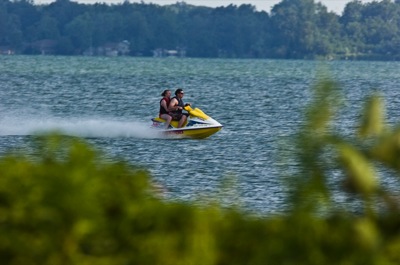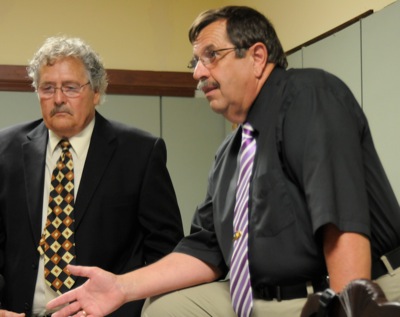Saturday, June 22nd, 2013
New group formed to help Grand Lake
Guardians want cost of lake cleanup shifted away from local residents and businesses, heavy fines for polluters
By Shelley Grieshop

Photo by Mark Pummell/The Daily Standard
A couple zips across Grand Lake on a Jet Ski earlier this week. The lake remains on an Ohio EPA posted recreational health advisory with toxins nearly three times higher than last year at this time.
CELINA - A new Grand Lake support group wants to force the state and negligent farmers to take responsibility for the polluted waterway.
Members of Guardians of Grand Lake St. Marys hope to shift the costly burden of clean-up away from local residents and businesses who've already suffered lower property values and lost revenue.
"The purpose of the Guardians of the Lake is to ensure that all parties with legal responsibility for protecting (the lake) and its tributaries from pollution are abiding by all laws and regulations through legal, scientific, economic, environmental, political and educational actions," said Kate Anderson, president of the nascent group.
The group is voicing its concern as data shows the algae toxin level in Grand Lake is several times higher than this time last year.
One of the guardians' missions is to push for heavy fines for polluters, such as culpable farmers, in the same manner the state goes after manufacturing corporations that violate regulations, according to Anderson.
"There should be no double standard for any manufacturing facility whether they manufacture livestock or other materials," she said.
The group wants the state to cap drain tiles so manure on farm fields can no longer pollute the lake, she said. Phosphorus from applied manure now flows via tributaries to the lake where it feeds toxic blue-green algae.
Anderson said the ultimate solution to the degradation of the lake is simple and free to taxpayers.
"If your phosphorus level is above that needed to grow good crops then you should not be permitted to apply any more phosphorus until the soil actually requires it," she said.
She suggested soil samples should be taken annually.
Anderson is the former secretary of the grassroots Lake Improvement Association. She and others left the organization because they felt it was ineffective, she said.
"I watched as the LIA moved away from working aggressively to hold the polluters accountable for flushing their farm manure into (the lake)," she said.
GOL's mission is starkly different than the LIA's, longtime LIA member Milt Miller said.
"We have two very different philosophies on how to accomplish restoring the health of the lake," he said.
Farmers aren't the only ones GOL will scrutinize.
"We believe the state of Ohio and the (Gov. John) Kasich administration are responsible for the pollution of the (lake) due to not enforcing all laws and regulations" and failing to dole out appropriate penalties for violators, Anderson said.
GOL members say the state wants local governments to pay for lake clean-up projects by raising property taxes and other means, and they believe that's wrong.
"These people aren't polluting the lake and with the possibility of the new Lake Facilities Authority, they will be asked to pay for the clean-up," she said.
An amendment is pending in House Bill 59 - the state's two-year budget - that would create a Lake Facilities Authority for Grand Lake to empower local officials. An LFA, for example, could place levies on the ballot to fund lake improvements. The budget must be approved by June 30.
Anderson said the state has allowed the Grand Lake Watershed to fall into the "distressed" level. The GOL wants the governor, state Sen. Keith Faber, R-Celina, Rep. Jim Buchy, R-Greenville, Ohio Department of Natural Resources and the state EPA to work "collaboratively on real solutions for our lake problems."
Kasich spokeswoman Connie Wehrkamp said the lake's health and the region's economic strength are major priorities of the governor.
"Since the governor took office, Ohio has spent more than $15 million to clean up the lake, and the administration has worked with the local community to develop and implement a plan that begins to address the harmful algae problems that have existed for decades," she said.
Wehrkamp noted the state began supporting lake clean-up projects within days of Kasich taking office. However, lawsuits filed against the state by property owners affected by spillway flooding have tied up funding, she said.
"The resources for these efforts ... are threatened by ongoing lawsuits regarding the Grand Lake St. Marys spillway from a handful of landowners," she said. "There is more we can and want to do in support of the lake and look forward to the time when that's feasible."
Anderson said recent claims boasting improvements in the lake's water quality are misleading. The lake remains under a posted recreational health advisory after "spending $20 million of taxpayers' dollars," she said.
Tests taken earlier this week showed microcystin levels around the lake ranging from 43.3 to 83 parts per billion - two to three times higher than samples taken in 2012 at this time. The World Health Organization's guideline for safe recreational contact is below 20 ppb.
The current health advisory notes that swimming and wading in the lake are not recommended for the very old or young and those with compromised immune systems.
Ohio EPA officials said the newest data isn't alarming because many factors, such as weather, cause algae toxin levels to rise and fall from week to week.
"So it isn't surprising to see numbers that are widely different from one year to another," EPA spokeswoman Dina Pierce said. "It is important to continue working on longterm projects to improve (the lake's) water quality."



